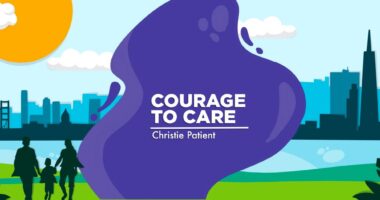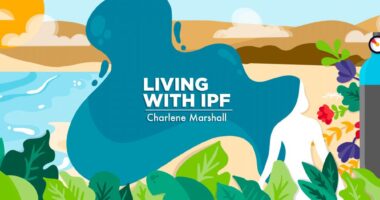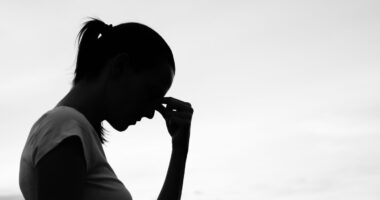Learning to live with both sleep apnea and pulmonary fibrosis
Having 2 conditions that affect my breathing takes a physical and emotional toll

Living with pulmonary fibrosis is already a daunting challenge, but when coupled with a sleep disorder like sleep apnea, the burden becomes even heavier.
Sleep apnea, a condition in which breathing repeatedly stops and starts during sleep, can significantly impact both sleep quality and overall health. For someone with pulmonary fibrosis (PF), where breathing is already compromised, sleep apnea exacerbates the struggle for oxygen, making restful sleep seem impossible.
A vicious cycle
PF causes scarring in the lungs, making it difficult for oxygen to pass into the bloodstream. This leads to symptoms like shortness of breath, coughing, and fatigue. Adding sleep apnea into the mix means that, during the night, the airway becomes blocked, reducing oxygen flow even further. This combination can lead to fragmented sleep, leaving you feeling exhausted, and it can also contribute to the progression of PF.
When sleep apnea is present in those of us with PF, the body is under even more strain. Oxygen levels can drop dangerously low during the night, leading to frequent awakenings and poor-quality sleep. This results in a vicious cycle where poor sleep exacerbates fatigue, further diminishing our ability to cope with the daily challenges of our lung disease.
After a recent sleep test, I was informed that my heart briefly stopped several times while I slept and that my oxygen levels dropped below 81%. This surprised me.
When breathing stops during sleep apnea episodes, blood oxygen levels drop. This signals the heart to work harder, which can lead to arrhythmias, or irregular heartbeats. Over time, untreated sleep apnea can cause serious complications such as high blood pressure, heart disease, and even heart failure.
Some symptoms of sleep apnea may include frequent awakenings, daytime fatigue, morning headaches, and shortness of breath.
The toll of 2 conditions
Coping with both sleep apnea and PF can be challenging, but incorporating certain lifestyle changes can help improve overall health and manage symptoms. Strategies include using a CPAP or BiPAP machine, adjusting your sleeping position, developing a steady bed routine, quitting smoking, avoiding alcohol before bed, and avoiding sleeping on your back.
The thought of using a CPAP or BiPAP machine fills me with fear. It’s not just about the machine itself, but everything it represents. The idea of needing a device to help me breathe properly while I sleep is a reminder of how much my health has changed and how much control I’ve lost over my own body.
The fear of feeling confined is very real. I worry about whether I’ll ever get used to it. Despite all this, I know I need to confront the issue. People with sleep apnea and PF use these machines every night and find relief. I hope that, in time, I can, too. But for now, the fear is real, and it’s something I’m working to overcome.
Living with two serious health conditions can take a physical and emotional toll. Sleep deprivation can lead to increased feelings of frustration, anxiety, and depression. Having a strong support system is vital. Whether it’s family, friends, or support groups, talking with people who understand your struggles can provide much-needed emotional relief.
Learning to live with sleep apnea and PF is a journey of balancing two chronic conditions. While it may feel overwhelming at times, with the right treatment and support, it can be bearable. Prioritizing sleep and working closely with your healthcare providers are key steps in improving both your sleep quality and your overall quality of life.
Note: Pulmonary Fibrosis News is strictly a news and information website about the disease. It does not provide medical advice, diagnosis, or treatment. This content is not intended to be a substitute for professional medical advice, diagnosis, or treatment. Always seek the advice of your physician or other qualified health provider with any questions you may have regarding a medical condition. Never disregard professional medical advice or delay in seeking it because of something you have read on this website. The opinions expressed in this column are not those of Pulmonary Fibrosis News or its parent company, Bionews, and are intended to spark discussion about issues pertaining to pulmonary fibrosis.









john william morley
Thank you for this very good report regarding sleep and disorders with PF I will watch our column very close from now on .From john morley Bishop Auckland County Durham UK
Lee Fogle
I have been diagnosed with sleep apnea since 2012 and pulmonary fibrosis since 2020. I am on oxygen 24x7, but exercise daily and walk over 10,000 steps daily. I tried CPAP devices and could not tolerate the sleep disruption. Since getting pulmonary fibrosis, I solve the problem of sleep apnea while also ensuring that I only nasal breathe, by simply putting a small piece of tape over my lips every night before bed. The tape is about the size of a postage stamp and is easy to flick off with my tongue if I need to cough, however, I sleep deeply all night with 97 to 99% oxygen saturation and since I begin mouthing four years ago, my sleep improved dramatically and continues to be very deep and restful. It’s a very simple noninvasive Technique that works extremely well for me and many people I know in the pulmonary fibrosis and sleep apnea community.
Ann Reynoso
Hi Lee. Thank you for sharing your experience with sleep apnea. It is interesting to know of another method. If the APAP machine does not work for me, I could give this option a try.
Jan Rosin
Dear Ann,
I have been using a cpap for more than 10 years even before my diagnosis of interstitial lung disease two years ago. Do not be fearful of the cpap. It is a tool that can help you get much better sleep with minimal problems. There are many different masks available. Your face does not have to be heavily covered. It takes a bit of getting used to but it is not difficult. I use a cpap with 2 liters of O2 fed into the hose. Over time my sleep apnea has been dramatically reduced and the extra oxygen is a real plus. I am able to keep my O2 in the healthy range all night and feel much better in the morning.
When you get your cpap fitting be sure to discuss your fears with the therapist. There are so many options available. Rather than being fearful, view this as an opportunity to use a great tool to help manage your disease. Embrace this new tool. Using a cpap is no biggie but it can be a big help to you.
Ann Reynoso
Thank you for your kind advice Jan. I need all the encouragement I can get. This is my first time using the machine. I am still new to my PF and now to have to deal with sleep apnea makes me a bit overwhelmed. So, thank you for reading my column and taking the time to respond.
Betty J Kunz
I live with both and I have learned to accept it. At night, I look forward to putting on the mask and getting the canula out of my nose. It has become comfortable and a part of my routine. I have no other choice.
Ann Reynoso
Thank you for reading my column Betty. I took was sleeping with my cannula and found it so difficult and uncomfortable. I am a side sleeper so my cannula would always shift to one side and it would end up hurting my nostrils. I am looking forward to see if using the APAP machine will be a bit more comfortable to sleep with.
MacPhilip
I’m 77 and have used a CPAP machine for 22 years.I never sleep without my machine and feel uncomfortable if I fall asleep without it.I use two machines my larger stay at home one and a mini one for travel or being away.Last year I was diagnosed with IPF after complaining to my GP for over a year about shortness of breath and being wrongly assured it was old pneumonia scarring.Changed my GP.you will get used to the mask.Common mistake when first using is to have it too tightly wear it so it’s just fitting.I also attend Buddhist meditation which I find not only helps my breathing but my attitude and emotional well being.Life’s good.h.Hope this is helpful. Mac
John
Thank you. I have autoimmune disease and ILD. It is tougher and hard to explain your fatigue for people who don't have it. I'm getting sleep test soon because i believe i drop below 90% about 20% of the night. Maybe they'll give me oxygen to sleep with. I appreciate you sharing
Ann Reynoso
Hi John. I appreciate your response. Good luck on the sleep test. I hope that you will get the treatment needed.
Debbie Gregory
I had no idea I had sleep apnea. I used a Wellvue ring (oximeter) over night and found my oxygen was dropping to 72. I had a in lab sleep test and it showed I had severe sleep apnea. Did not need oxygen, I needed a CPAP machine. Now I stay above 90 all night. Eventually I will need oxygen but it can be run through the CPAP machine.
Ann Reynoso
Hi Debbie. Thank you for reading my column. I am happy to hear that your CPAP has helped you. This gives me encouragement.
Malcom Philip
Like Ann I have both sleep apnea and idiopathic pulmonary fibrosis.I have used a CPAP machine after belatedly diagnosed with severe obstructive sleep apnea 22 years ago.Now 77 years old I was diagnosed with IPF last year after suffering breathing difficulties for about two years and have 43 per cent breathing capacity.I’m so used to wearing aCPAP mask that I feel uncomfortable falling asleep without it.Don’t wear the mask too tight just as loose as possible but still be airtight.I have a beard and still get adequate air pressure.
I also attend Buddhist meditation which helps not only my breathing but emotional well being and attitude.
Life’s good.Hope this helps
Mac from Wollongong Australia
Ann Reynoso
Thank you Malcom for responding to my column. I think I will give meditation a try. I did meditation a while ago before my diagnosis, but did not keep up with it. I think it's time to get back into it.
Barb Gulick
I have been using a CPAP machine for almost 20 yrs. I’ve been on O2 for a couple of yrs. My O2 connects to my CPAP machine at nite and before going to sleep, my O2 is often 98. When walking during the day my O2 is often in mid 80’s. Make sure you can connect your O2 to your CPAP machine.
Ann Reynoso
Thank you Barb for the advice about connecting my O2 to my APAP machine. I did attend a class for my new APAP machine and they showed me how to connect my O2. I hope this will help me with my issue of my heart beat stopping during sleep.
Adele B Friedman
I am in a trial of a CPAP after finding out via a home slieep study I have mild apnea. (Average 10.4 apneic events/hour) This is mild, which is considered to be 5-15 apneic events/hour, average. So far, I have yet to find any benefit from the CPAP and it does make it harder to fall asleep. CPAP may be even less ideal for someone like me, whose main problem has always been being able to get to sleep. I first tried the minimalist "nasal pillows" headgear. Minimal should be best, right? Not exactly: if you open your mouth more than a tiny bit, air rushes out your mouth, very startling, especially if you've managed to fall asleep at all. I'm trying nose and mouth covering mask now. Sleep can be obtained, some nights. I've also had several nights where after trying to fall asleep for 1-2 hours, I give up and resume oxygen only--a process which of course wakes me up a bit more. My ILD specialist said there is no good data, at least yet, showing that treating MILD apnea leads to better PF outcomes. Obviously whether CPAP makes you sleep better and feel better is very individual, as are people's co-morbidities, arrhythmias, etc. Unfortunately, I have yet to find any benefit and am finding a lot of drawbacks.
Ann Reynoso
Thank you Adele for reading my column. It has been a struggle having PF and now adding another issue can be frustrating. I hope that I can find the acceptance of having to use a APAP. I am nervous that it will bother me when I sleep. I hope to later write about my experience. I hope that you will find a better treatment to help you sleep better.